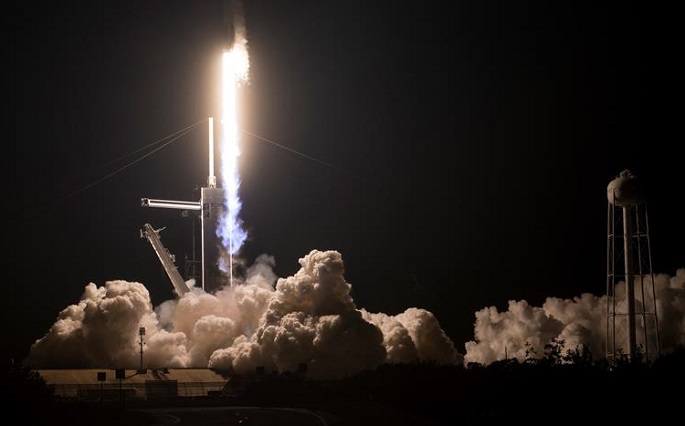SpaceX, NASA begin new phase of manned missions to space
Published : 16 Nov 2020, 11:12
Private aerospace company SpaceX sent its first manned taxi mission to the International Space Station (ISS) on Sunday, reported EFE-EPA.
Launched for NASA in its first full taxi flight for a private company, the capsule carries four astronauts: Americans Shannon Walker, Michael Hopkins and Victor Glover, and Japan's Soichi Noguchi.
The Falcon 9 rocket carrying the Dragon capsule successfully lifted off from Cape Canaveral in Florida, United States, at 7.27 pm local time.
At around 7.40 pm, the capsule, called Resilience, was finally in orbit towards the ISS after separating from the rocket, a part of which successfully returned to Earth on a floating platform in the Atlantic.
SpaceX founder Elon Musk, who said in a tweet on Sunday that he was "most likely" to have "a moderate case of Covid" was forced to watch from afar and tweeted a heart emoji when the capsule and rocket successfully separated.
Musk's company intends to use the returning part of the rocket for the next mission to the ISS under a partnership with NASA, which is scheduled to take place in March next year.
The Dragon capsule is the first privately owned and operated spacecraft to be certified by NASA for manned spaceflight following the success of the Demo-2 test mission to the ISS, which was launched in May with two astronauts on board and returned safely to Earth on Aug. 2.
The start of these manned missions opens up the possibility for NASA to send regular crews to the ISS, and possibly astronauts to the Moon and Mars, in association with private companies in charge of building and designing spacecraft and rockets, which function as space taxis.
After taking off from the historic launch pad 39A at Cape Canaveral - from where the Apollo 11 mission that reached the Moon in 1969 was launched - the capsule should arrive around 11 pm on Monday at the ISS, a "space laboratory" orbiting about 250 miles (about 400 kilometers) above Earth and which celebrates its 20th anniversary this year.
Upon its arrival at the space station after a trip in which the capsule will reach a speed of 27,000 kilometers per hour, the four astronauts will be received by NASA's Kate Rubins and the Russian cosmonauts, Sergey Ryzhikov and Sergey Kud-Sverchkov, and will stay there for six months.
The first of at least six missions that SpaceX will carry out to the ISS under a multi-billion-dollar contract signed with NASA in 2014 took off on schedule without any mishaps but after a series of postponements.
The mission was originally scheduled for Oct. 23, but was postponed to Oct. 31 and then undated until NASA announced in late September that it would be launched on Saturday.
The penultimate postponement was due to the discovery of a problem in the Falcon 9 engine during a recent non-NASA mission launch attempt.
Falcon 9 was scheduled to take off around 8 pm on Saturday, but both SpaceX and NASA decided to postpone the launch to the following day on account of bad weather caused by the tropical storm Eta, which crossed north Florida and caused flooding due to heavy rains in the state.
According to the mission's managers, the launch was delayed to ensure that the landing platform that was to receive part of the rocket in the Atlantic would reach its position.
On Friday, NASA administrator Jim Bridenstine said that "the ultimate goal is to have more resources, to do things for which there is not yet a commercial marketplace, like go to the Moon and on to Mars under the Artemis program."
"When we have additional astronauts, a full complement of crew on the International Space Station, the amount of research is going to be transformational," he added.


